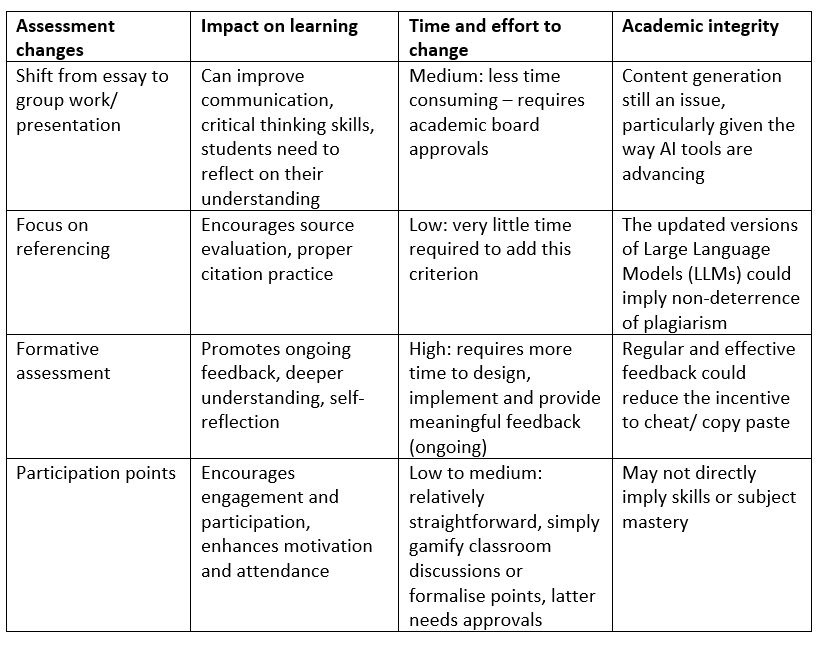Dr Swati Virmani – Senior Lecturer and University Teacher Fellow, De Montfort University, UK; swati.virmani@dmu.ac.uk
Anshul Lau – Senior Learning Innovation Technologist, Keele Institute for Innovation & Teaching Excellence (KIITE), Keele University, UK; A.Lau2@keele.ac.uk
The rapid advancement of Generative AI (GenAI) has presented both opportunities and challenges for educators. Traditional assessment formats, such as essays, project reports, and now even problem-solving based questions, are particularly vulnerable to misuse. When considering assessment formats, discussions revolve around whether the format makes it easier to cheat without demonstrating learning. As educators, we must adapt our assessments to ensure the quality of our degrees and promote genuine student learning while still allowing students to benefit from the productive use of GenAI. So how do we conceptualise the change?
Our core objective remains unchanged – to design assessments that test students’ knowledge and cultivate critical thinking and deeper engagement. To achieve this, we must create assessments to mirror real-world scenarios and provide a supportive and inclusive classroom environment that encourages active participation. However, we should also carefully consider the time required to carry out these changes and weigh them against the potential impact on student learning. The figure provided below outlines our thought-process for identifying the most fruitful way towards assessment changes. We want to offer this as a starting point. It emphasises the need to balance the impact of a potential change on student learning (horizontal axis) with the time required to bring about the change and its successful implementation (vertical axis). Our goal is to prioritise assessment changes that significantly improve student learning outcomes, are feasible, and address concerns around the authenticity of students’ work.
Let us break it down!
Horizontal Axis (Impact): measures the degree to which an assessment format influences positive changes in student learning outcomes. Assessments that lead to greater understanding, skill development, and knowledge retention would be placed further to the right.
Vertical Axis (Time): indicates roughly how much time and effort educators would invest in modifying or redesigning a particular assessment format. Assessments that demand significant changes would be placed higher vertically.
Ideal Zone: would be high in impact yet lower in the time required for modification, and include techniques that balance efficiency with effectiveness.

For impact, think around questions such as which specific learning outcomes does the assessment measure?; how does it promote application beyond the test/ exam?; does it provide opportunities for students to receive feedback to improve? With regards to time, the changes could depend upon how much time is needed to design or adapt the assessment?; does the time invested align with the potential impact on student learning?
One thing is clear – the need to shift from detection to prevention.
Instead of solely relying on detection and identification of misuses of GenAI, which can be time-consuming and not fool proof, we suggest employing a multi-faceted approach to explore formats that deter cheating in the first place.

In summary, formative assessments and well-designed classroom activities have the highest impact on learning, although they can be time-intensive. Balancing impact, time investment, and academic integrity is an ongoing challenge. As a starting point, we propose a thoughtful combination of different formats, along with clear communication and ongoing reflection, to create a supportive learning environment. A few suggestions for extending and adapting the strategy:
- Identify additional assessment formats relevant to your discipline, plot them on the figure based on their potential impact on learning and time required to implement them.
- Consider factors that may influence the positioning of assessment formats on the figure, such as the level of student engagement, feasibility of implementation given any institutional constraints.
- Engage in ongoing reflection by periodically revisiting your assessment designs using the figure, and make necessary adjustments based on student feedback.
- Explore ways to effectively incorporate GenAI within assessment formats – a piece for another blog discussion!
Remember, there is no single ‘perfect’ solution, and the most effective approach will depend on your specific context, learning objectives, and available resources.
Dr Swati Virmani is a Senior Lecturer in Economics and Deputy Director of the Doctor of Business Administration Programme at De Montfort University, UK. She is an Associate at the UK’s Economics Network and has recently been awarded the University Teacher Fellowship. She has a widespread experience in developing curricula at undergraduate, postgraduate, and enterprise levels. Swati brings deep understanding of AI-based interventions, effective use of Large Language Models (LLMs), and development of customised GPTs. Her research focuses on AI’s impact on professions, building inclusive smart cities, and working with people from different backgrounds and underrepresented groups to expand unbiased knowledge about data science and AI.
Anshul Lau is a Senior Learning Innovation Technologist, at Keele University, UK. He is a Senior Fellow of the Higher Education Academy (SFHEA), Certified Member of the Association for Learning Technology (CMALT), and a Certified LEGO® Serious Play® facilitator. In his role, Anshul partners with key stakeholders to develop and implement comprehensive roadmap for learning innovation, ensuring institutional pedagogic approaches are enhanced through effective use of technology. He leads strategic digital education projects and collaborates closely with Information and Digital Services (IDS) to select the best platforms and technologies and design learning analytics evaluation process.
